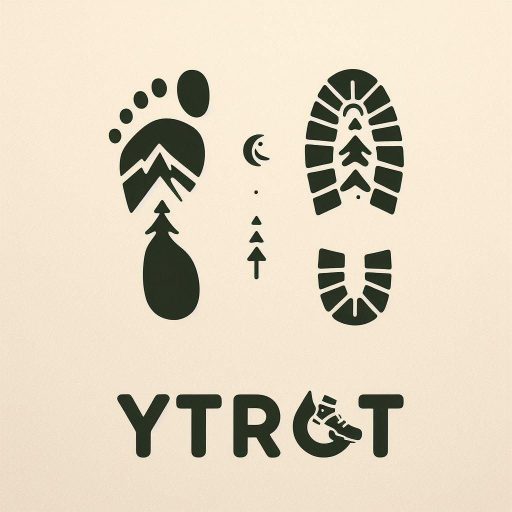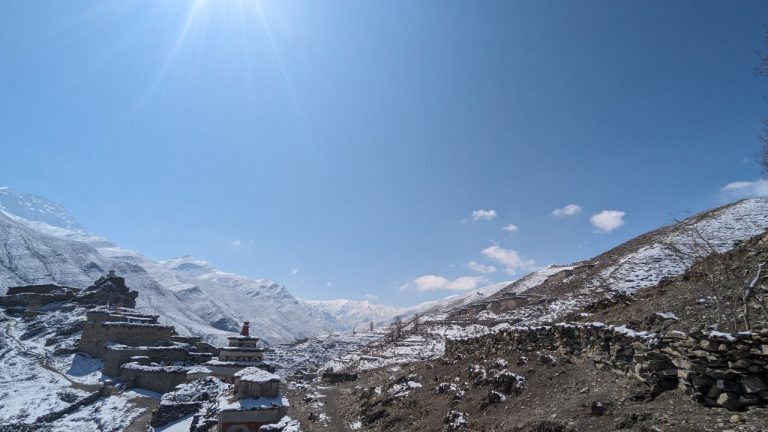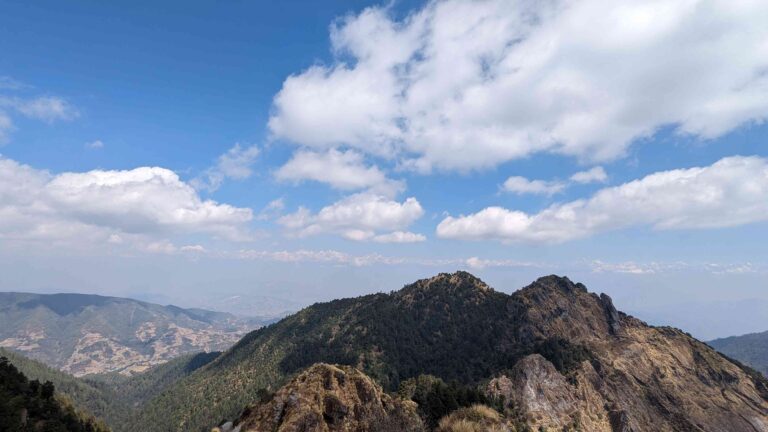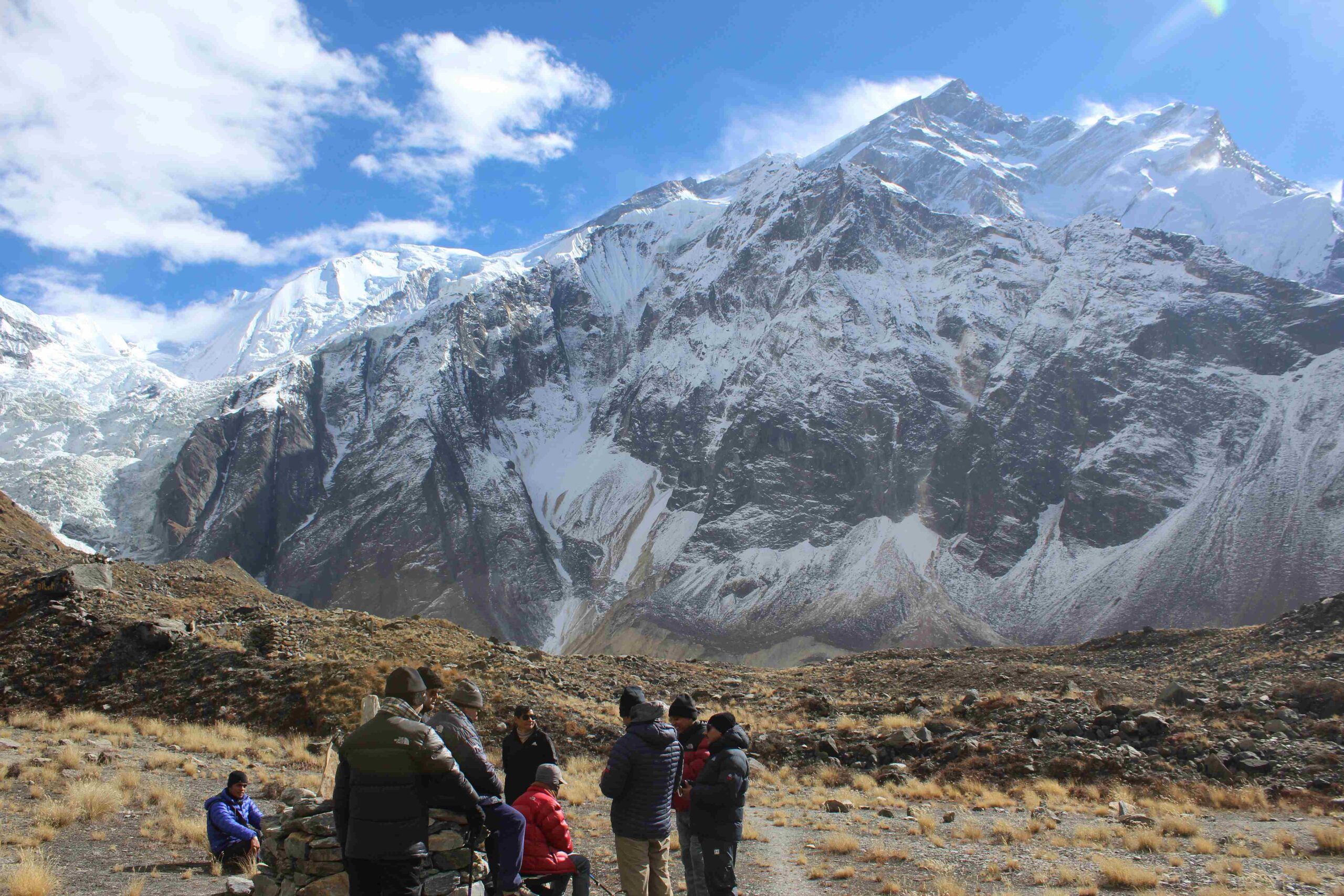Thorong La Pass, also known as Thorung La, is a mountain pass in central Nepal’s Damodar Himal, which is located north of the Annapurna Himal. It is 5,416 meters (17,769 feet) above sea level. Thorong La is the highest point on the 300 km (190 mile) long Annapurna Circuit, which encircles the Annapurna mountain range.The mountains that make up Thorong La are Khatung Kang and Yakawa Kang. The pass is situated along a trail that links the Mustang District’s Muktinath temple and the surrounding village of Ranipauwa to the west with the village of Manang in the Manang District to the east.
Thorong La Pass Trek is one of the most well-known trekking trips in Nepal. As you go from subtropical jungle to the high, extremely dry terrain that mimics the Tibetan Plateau, the trip passes through a myriad of biomes. The Thorang La Pass trip leads you past the Kali Gandaki Gorge, the deepest gorge in the world, and then across one of the highest passes in the world. The region also has a wide range of cultural diversity due to the several tribal and ethnic groups who call it home, coexisting peacefully and in harmony as they have done for millennia.
Details of Thorong La Pass Trek
| Name of the Trek | Thorong La Pass Trek |
| Trekking Region | Annapurna Region, Mustang and Manang Districts |
| Trekking Difficulty | Strenuous; needs previous experience of trekking at high altitude |
| Number of Days | 13-14 days |
| Maximum Elevation | 5845 m |
| Accommodation | Homestay, tea houses at first and camping |
Highlights of Thorong La Pass
- Panoramic mountains and diverse ethnic villages
- Sightseeing around Manang village and visit Gangapurna Glacier Lake
- Crossing the Thorung-La Pass over 5416 meters
- The Pilgrimage town of Muktinath, Apple field villages down from Muktianth
- Walking through the world’s deepest gorge and the Kaligandaki valley
Short Itinerary of Thorong La Pass Trek
| Day | Activity | Altitude | Time |
| Day 1 | Arrival at Kathmandu | 1400m | – |
| Day 2 | Explore Kathmandu Valley and Preparation | 1400m | – |
| Day 3 | Drive to Chame | 2710m | 9 hours drive |
| Day 4 | Trek from Chame to Pisang | 3300m | 6 hours trek |
| Day 5 | Trek from Pisang to Manang | 3500m | 6 hours trek |
| Day 6 | Acclimatization Day at Manang | 3300m | – |
| Day 7 | Trek from Manang to Yak Kharka | 4100m | 7 hours trek |
| Day 8 | Trek from Yak Kharka to Thorang Phedi (Base) | 4600m | 4 hours trek |
| Day 9 | Cross Thorang La Pass and trek to Muktinath | 5416m to 3800m | 8 hours trek |
| Day 10 | Explore Muktinath, Kagbeni and Marpha Village | 2700m | – |
| Day 11 | Drive or Fly Back to Pokhara | 822m | 8 hours drive/30 mins flight |
| Day 12 | Explore Pokhara | – | – |
| Day 13 | Drive or Fly Back to Kathmandu | 1400m | 8 hours drive/40 mins flight |
Detailed Itinerary of Thorang La Pass Trek
Day 1: Arrival at Kathmandu
You arrive at Tribhuvan International Airport (TIA) in Kathmandu, capital city of Nepal. You then will transfer to a hotel of your choice, probably freshen up and go on to explore Thamel. Thamel is the tourist hub of Kathmandu.
Day 2: Explore Kathmandu Valley
Today you spend the day resting and exploring the Kathmandu valley. The historical and cultural diversity of the Kathmandu Valley is immense. The Kathmandu Valley has 8 UNESCO World Heritage Sites. You may view the complex architecture of the former Malla dynasty by visiting the historical palaces in Hanuman Dhoka Durbar Square, Patan Durbar Square, and Bhaktapur Durbar Square. Hinduism and Buddhism, two of the most well-known religions in the world, boil in the pot of Kathmandu Valley. One of the largest Hindu holy sites is the PashupatiNath temple, and Swambhunath (Monkey Temple) and Bouddhanath are two of the most important monasteries for Buddhists.
Day 3: Drive to Chame
The journey we’re taking today is a picturesque drive from Kathmandu to Chame. The district headquarters of Manang is Chame. You will be riding by the banks of perennial rivers like the Trishuli and Marsyangdi. On top of that, the trip will be further complemented by the periodic views of the Annapurna Mountain range, Lamjung Himal, Fishtail, and more. The road to Beshisahar is good at first, but it becomes rougher as it goes on. The recently built gravel road will be full of jolts and bumps, but the gorgeous route will make up for the inconvenience. Chame can be reached from Kathmandu in 9 to 10 hours. When you arrive in Chame, you will be transferred to a lodge where you will spend the night.
Day 4: Trek to Pisang
You will continue on the trek via the rocky track and uneven green woodland after breakfast. Through the Manang Valley, you are traveling along the Marsyangdi Nadi (river). The upper Pisang provides you distinctive sceneries, breathtaking Himalayan views, and the tranquil, captivating surroundings. You will descend into Manang, a U-shaped valley sandwiched between two snow-capped peaks. You will arrive in Pisang for an overnight stay. As we make our way to Pisang, the trail rises 1500 meters above the river. 5 to 6 hours are required for the trek.
Day 5: Trek to Manang Village
You will take the trail today to the village of Manang. Along the route, you will pass through gorgeous views, unusual vegetation, a dry, cold climate, and the Braga monastery. The largest monastery in the Manang district is called Braga. We move on after visiting Braga as we observe that the foliage is progressively decreasing by the hour. Manang is a well-known village that takes the name after the region and district itself.
Day 6: Acclimatization and Explore Manang Village
You’ll take the day off to relax and wander the village. With this extra day, your body will have enough time to adjust to the high altitude you are in. Learn more about the community and its ethnic groups, particularly the Gurung, Magar, and Bhotia. A peaceful view of the Annapurna II, III, Gangapurna, and Tilicho Peaks, with their rugged terrain and unusual communities will undoubtedly blow your mind.
Day 7: Trek to Yak Kharka
Following the creek, you will climb the trail while navigating Juniper and Pine trees. Yak Kharka, which means “yak pasture,” is a grassland. The Himalayan grassland is rich in medicinal plants that are beneficial to animals.
Along the trip, you’ll pass by grazing horses and yaks, Mani Walls, a group of mud roofs, rivers. You’ll see grazing horses and yaks, Mani Walls, a collection of mud roofs, and rivers as you proceed. The temperature is steadily dropping while the altitude is rising. Therefore, it is crucial to remember to retain heat. Overnight at a lodge in Yak Kharka.
Day 8: Trek to Thorang Phedi
Today we will be walking upto the base of Thorang La. Phedi means base in Nepal. Today, you will have to gain significant elevation in small amount of time. So, the walk will be steep. As you proceed through the cliffs, you will be treated to breathtaking views of the snow-covered mountains and stunning desolate regions. You may hear your own voice echoing back to you from the isolated location.
Day 9: Cross Thorang La Pass and Trek to Muktinath
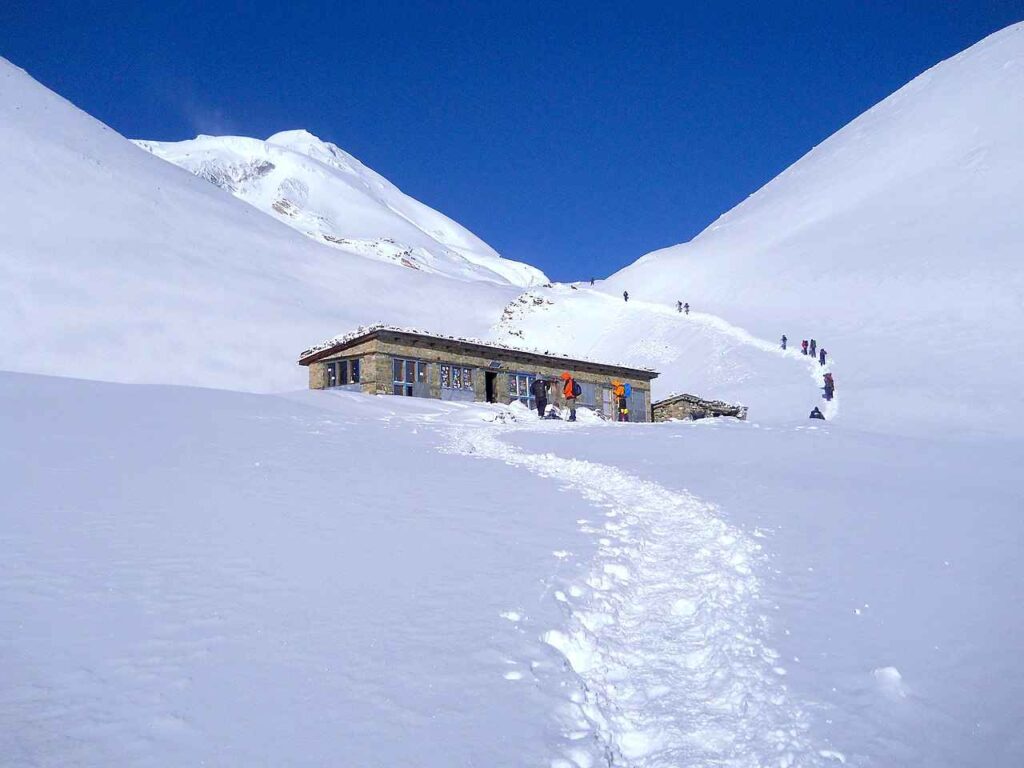
Today is the most challenging part of the trek so far but also the most exciting. You will be crossing one of the highest passes in the Himalayas. You begin before daylight with the goal of reaching the pass by 9 or 10 a.m. Otherwise, the route will be significantly impacted by the weather especially strong cold wind at the Thorong La Pass. We follow a predictable and simple route as we climb steeply. You will be rewarded with breathtaking views from the summit of the pass after four hours of hiking highlighted by the chortens and prayer flags.
Crossing the pass, you the climb down to Muktinath, one of the most holiest shrines of the Hindus. After crossing the pass, you must descend to Muktinath, one of the holiest Hindu sites. The name Muktinath, which means “site of nirvana,” is the location of the Muktinath Temple and a number of monasteries. Both Hindus and Buddhists visit this holy location to make pilgrimages. The Lord Vishnu-dedicated temple is surrounded by 108 waterspouts. The Jwala Mai Temple, which features a beautiful natural spring and an eternal flame powered by natural gas, is another attraction in the area.
Day 10: Explore Muktinath, Kagbeni and Marpha Village
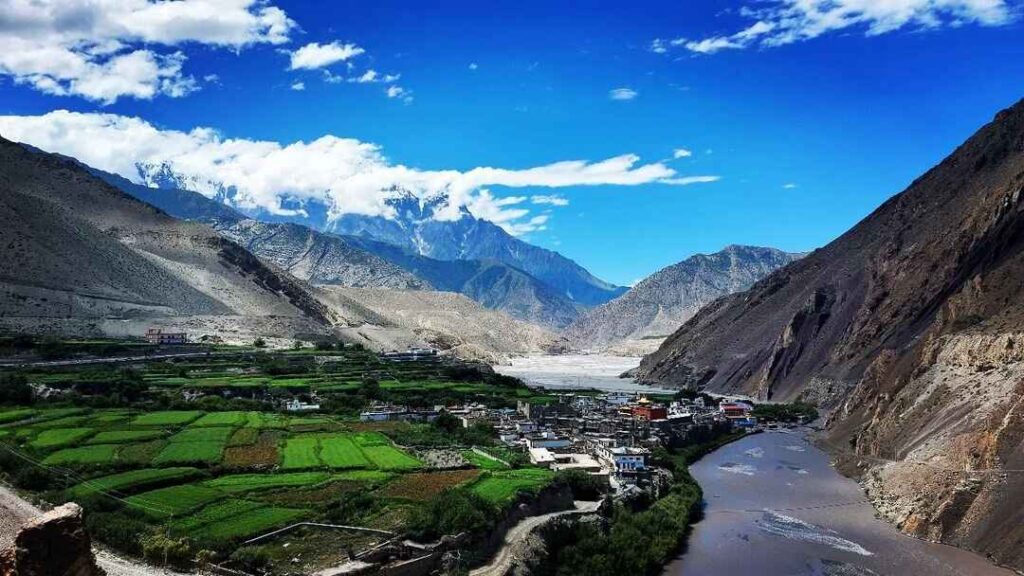
Today you explore the major tourist attractions of Mustang; Muktinath, Kagbeni, Marpha.
Kagbeni is a distinctive and well-known settlement in the Barah Gaun (twelve villages) section of the Mustang province, located at a height of 2,800 meters. It is an intriguing medieval settlement with densely populated mud brick homes, shadowy lanes, and towering Chhortens. The red monastery that sits at the center of the village’s lush oasis dominates the area. The “Kag” of “Kagbeni,” which formerly stood for “Ghag,” or center, is now the hub of the neighboring villages of Jomsom to the south and Muktinath to the east. In Nepali, the word “Beni” refers to the meeting of two rivers, and Kagbeni is located on the banks of the Kali Gandaki and Jhong Rivers.
Similarly, you also make your way to Marpha village, the apple capital of Nepal. The village of Marpha is located 2,680 meters above sea level. Particularly the attractiveness of the location are the green and red apples. Additionally, one should sample a local apple brandy. It will provide the fatigued body with some much-needed regeneration. In addition to producing apples and wine, this area is well known for its Thakali population, their distinctive style of building, and their culture and traditions.
Day 11: Drive or Fly Back to Pokhara
The drive to Pokhara takes around 8-9 hours along the bumpy, muddy road. If the drive is too taxing for you, you can take mountain flight back to Pokhara.
Day 12: Explore Pokhara
Pokhara is a tourist paradise with all of the modern conveniences. We strongly advise you to explore Pokhara so that you can learn about other cultures and visit a variety of popular tourist destinations. The city is also called city of lakes with prominent lakes Phewa, Begnas and Rupa to name a few.
Day 13: Drive of Fly Back to Kathmandu
Your journey ends here as you make your way back to Kathmandu.
How Difficult is Thorong La Pass Trek?
